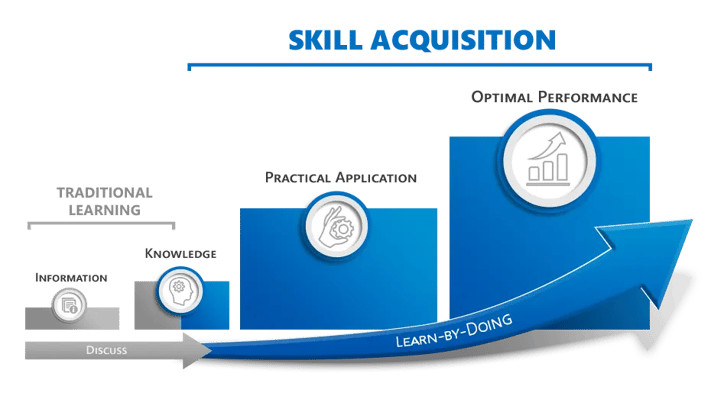
This article was published in e-Learning Industry on January 11, 2018 (link here)
Learn how to use virtual game technology to enable your learners to practice in realistic situations and more rapidly learn optimal decision making. A 4-step process is described to create an effective, scalable, digital learning solution to improve performance using 3D game technology.
How to Transform Your Training Program and Improve Performance with Game Technology
Game technology intuitively presents tremendous potential for learning. Players learn complex processes and improve their performance over time. It’s a learning environment! Yet, simply learning through games does not work so well in most training situations.
Entertainment technology entertains. It’s powerful, but must be adapted for learning applications. Today, we’ll explore how we can use game technology to enable trainees to practice making optimal decisions in diverse applications, such as clinical training, sales training, customer service, patient coaching, and employee performance. Let’s see how….
Where Will Your Trainees Practice?
Some believe learning ends with a test. An assessment marks the end of knowledge acquisition, and the beginning of the most impactful, difficult phase—skill acquisition—where one applies that knowledge in real-world situations. This is the skill of making the right decisions; of understanding what to do in practical situations, based on the acquired knowledge.

This skill-acquisition process is where we can achieve big gains in performance. Learners need a place where they can practice and be actively coached, to hone their skills safely. In one-on-one live training, we know how to do this. Doing it digitally is much harder! This is one area where even the most fancy, gamified eLearning packed with game-play, falls short. Instead, 3D game technology can be used to create realistic learning environments with conversant virtual humans for skill acquisition.
Going Beyond Gamification for Rapid Skill Acquisition
Gamified apps are the rage right now. Gamification adds reward systems, badges, and a sense of progression that helps with engagement, but for skill acquisition, a deeper approach is needed. Simply adopting a game genre for your learning platform will not be effective. Instead, we must strive to optimize the attributes of this powerful technology that align with our learning goals.
How do we get started? Let’s begin by thinking about how we would train someone to perform a skill in the real world, then we can emulate it in a scalable, cost effective, digital environment. This means understanding our learning goals, and the learning methodologies we would use in a real-world situation. Then we can develop an approach to simulate what works in the real world, within an online program. The higher the realism in the virtual version, the better it will reflect performance in real-life – only in a scalable, digital format. So, the application of technology is targeted and deliberate. Easier said than done, right? Let’s discuss the elements that make up a successful solution.
4 Steps to Create an Effective, Scalable Digital Learning Solution to Improve Performance With Game Technology
1. Define Learning Objectives
Yes, this seems prosaic, but there’s an important point here. Your learning objectives determine what technology makes the most sense:
- If the focus is around knowledge acquisition, then the goal is to introduce information into an organizing framework. Many traditional eLearning approaches, including gamified ones, can effectively do this; introducing more advanced technology will not result in a practical benefit.
- If the focus is to gain competence in applying the knowledge, in realistic situations, then we’re talking about performance. This is where using advanced game technology can make sense, and lead to big improvements.
2. Map Out A “Live” Training Experience
Once the learner has the requisite knowledge, how do you train them to apply it in practical situations? Let’s start by mapping out what you would do in live training.
For example:
Your live training experience could use experiential learning and create realistic situations through role-play or case studies, where the learner makes decisions. You could also provide expert mental models on how to approach a situation, and actively coach the learner to decide on the optimal approach; these are the main tenants of cognitive apprenticeship. Finally, you could provide many different scenarios, so they can recognize optimal patterns, and apply expert mental models in fluid situations (cognitive flexibility theory).
3. Digital Transformation
To make the live training experience scalable and free of geographic constraints, we need to emulate the “live” training digitally. The better the digital experience emulates a fluid real-life situation, the more immersed the learner will be, and the faster they will learn.
By creating virtual peers, prospects, customers, patients, and virtual coaching mentors that interact in dynamic conversations and respond to decisions in real time, learners discover and practice optimal decision making that can then be applied in real-world situations. Most importantly, include real-time coaching in your solution to exponentially increase the learning rate, over the repetitive, trial-and-error-based learning that’s common in games.
4. Measure Results!
With all the decision making captured digitally, it is important to measure where learners are struggling and how they are progressing in a standardized training program. This gives you return on your education metrics.
It’s challenging to transform what works in live training into an effective, scalable digital format. Game technology combined with cognitive science methodologies, provides us with an exciting new way to improve decision making and real-world performance. If you want your trainees to apply their knowledge in real world situations, providing virtual experience in a safe environment is worth considering.
About Syandus: Virtual immersive learning technology that transforms knowledge into real-world performance. We immerse participants in realistic virtual situations with one-on-one expert coaching that gives them experience making optimal decisions. Syandus Learning Modules combine cognitive science principles, the realism of game technology, and our customer’s proprietary content, to deliver rapid skill acquisition. Modules are cloud-based for easy deployment, fully trackable with embedded analytics, and can be used on any web-enabled device.



.jpg)